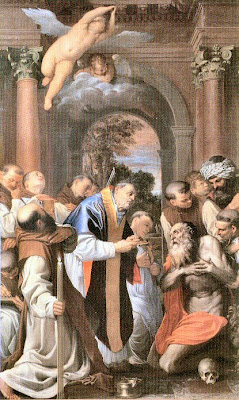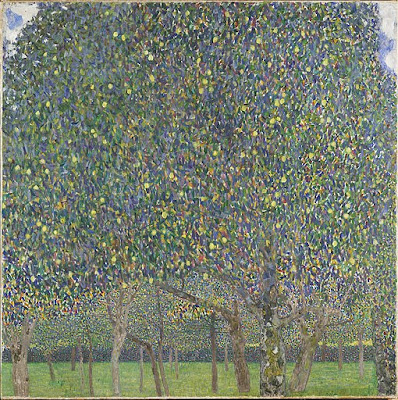Joachim Patinir (Netherlandish, active by 1515, died 1524)
The Penitence of Saint Jerome, triptych, ca. 1518
Oil on wood
Shaped top: central panel, overall, with engaged frame, 46 1/4 x 32 in. (117.5 x 81.3 cm); each wing, overall, with engaged frame, 47 1/2 x 14 in. (120.7 x 35.6 cm)
The Metropolitan Museum, New York
The gallery label for this beautiful work states:
"A milestone in the history of European landscape painting, this intact altarpiece may have been made for a church in southern Germany. Its outside wings show Saint Sebald, patron saint of Nuremberg, and Saint Anne with the Virgin and Christ Child.
Following Netherlandish tradition, large-scale sacred figures dominate the foreground: Christ, who is baptized in the Jordan River, Saint Jerome, and Anthony the Hermit (shown with the monsters that assailed him).
The true subject of the picture, however, is Patinir's splendid panoramic landscape, which the viewer is encouraged to travel through visually in the manner of a pilgrimage"
Patinir often let his landscapes dwarf his figures, which were often painted by other artists.
Patinir was a pioneer of landscape as an independent genre and he was the first Flemish painter to regard himself primarily as a landscape painter
It has been said that Patinir's religious subjects incorporate precise observation and naturalism with fantastic landscapes inspired by the northern traditions of Bosch.
Joachim Patinir painted similar works on the theme of St Jerome. See below. Again the landscape is to the fore.
But each painting is a reflection or meditation on St Jerome. The works encourage reflection and meditation. They are not as didactic as the Counter-Reformation and baroque paintings.
The painter would have assumed a knowledge of the Life of St Jerome on the part of the viewer. The details of his life would have been well known. In the paintings there are precise symbols: Christ - the Spiritual Rock and source of living water; Christ - the Good Shepherd. There are also details which remind us of the particular moments in the life of St Jerome: the lion which was cured; the Cardinal`s habit; the books which he studied and so on. These symbols and details would have reminded the viewer of the various incidents and motifs from the life of St Jerome.
There is a timeless quality about the paintings. It is as if the scene which they portray could be the 4th Century or any time either before or after. What we are looking at is an eternal verity. It transcends a particular culture and moment of time.
Is there not also a rather subtle moral theme. In the pictures we see what appears to be a rather insignificant man, a tramp, an eccentric. Man or a man is shown to be a mere speck on the face of the Earth. Yet for some reason this man`s works live on and his memory is preserved and honoured as the greatest of the Doctors of the Church. The parable of the Mustard Seed comes to mind. He was humble in the face of Christ. He became exalted. He immersed himself in Scripture. He became a living Scripture.
Joachim Patinir (Netherlandish, active by 1515, died 1524)
St Jerome in Rocky Landscape
c. 1520
Oil on oak, 36,5 x 34 cm
The National Gallery, London
Joachim Patinir (Netherlandish, active by 1515, died 1524)
Rocky Landscape with Saint Jerome
Oil on wood, 47,2 x 37,3 cm
Museum Mayer van den Bergh, Antwerp
Joachim Patinir (Netherlandish, active by 1515, died 1524)
St Jerome in the Desert
c. 1520
Oil on wood, 78 x 137 cm
Musée du Louvre, Paris
Joachim Patinir (Netherlandish, active by 1515, died 1524)
Landscape with St Jerome
1515-19
Oil on panel, 74 x 91 cm
Museo del Prado, Madrid
We shall leave the final word to Pope Benedict XVI. On 7th November 2007, he concluded the first part of his Catechesis on St Jerome as follows:
"What can we learn from St Jerome?
It seems to me, this above all; to love the Word of God in Sacred Scripture. St Jerome said: "Ignorance of the Scriptures is ignorance of Christ".
It is therefore important that every Christian live in contact and in personal dialogue with the Word of God given to us in Sacred Scripture.
This dialogue with Scripture must always have two dimensions: on the one hand, it must be a truly personal dialogue because God speaks with each one of us through Sacred Scripture and it has a message for each one.
We must not read Sacred Scripture as a word of the past but as the Word of God that is also addressed to us, and we must try to understand what it is that the Lord wants to tell us.
However, to avoid falling into individualism, we must bear in mind that the Word of God has been given to us precisely in order to build communion and to join forces in the truth on our journey towards God.
Thus, although it is always a personal Word, it is also a Word that builds community, that builds the Church.
We must therefore read it in communion with the living Church. The privileged place for reading and listening to the Word of God is the liturgy, in which, celebrating the Word and making Christ's Body present in the Sacrament, we actualize the Word in our lives and make it present among us.
We must never forget that the Word of God transcends time. Human opinions come and go. What is very modern today will be very antiquated tomorrow. On the other hand, the Word of God is the Word of eternal life, it bears within it eternity and is valid for ever. By carrying the Word of God within us, we therefore carry within us eternity, eternal life.
I thus conclude with a word St Jerome once addressed to St Paulinus of Nola. In it the great exegete expressed this very reality, that is, in the Word of God we receive eternity, eternal life. St Jerome said: "Seek to learn on earth those truths which will remain ever valid in Heaven" (Ep. 53, 10). "





























